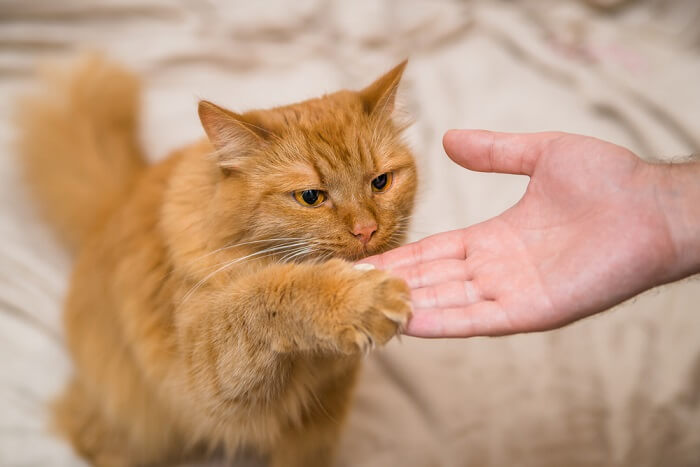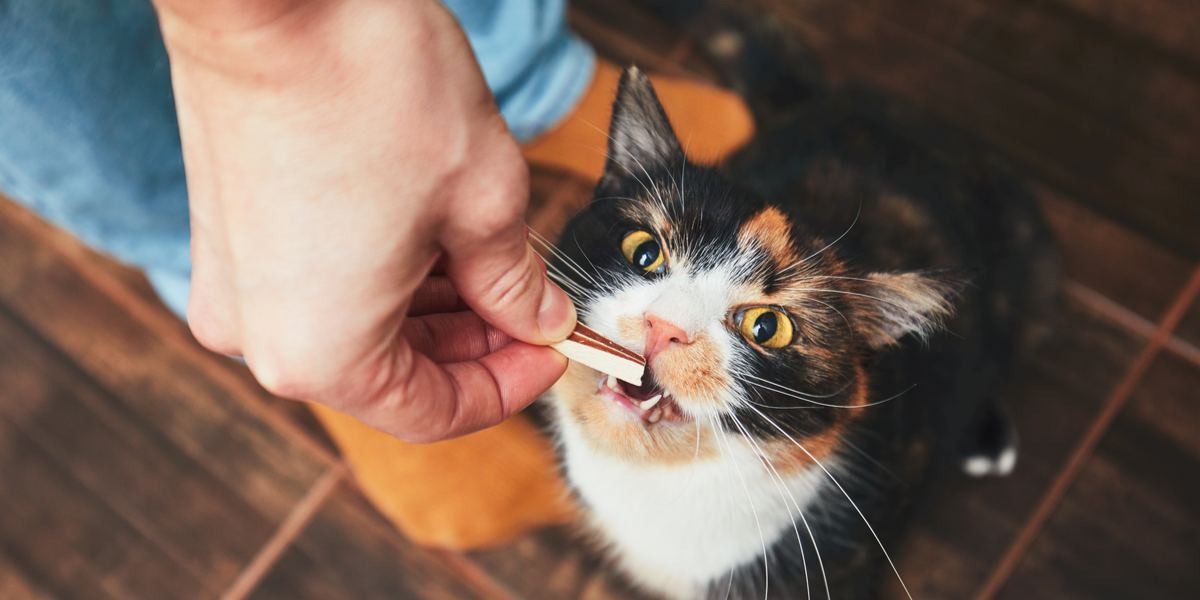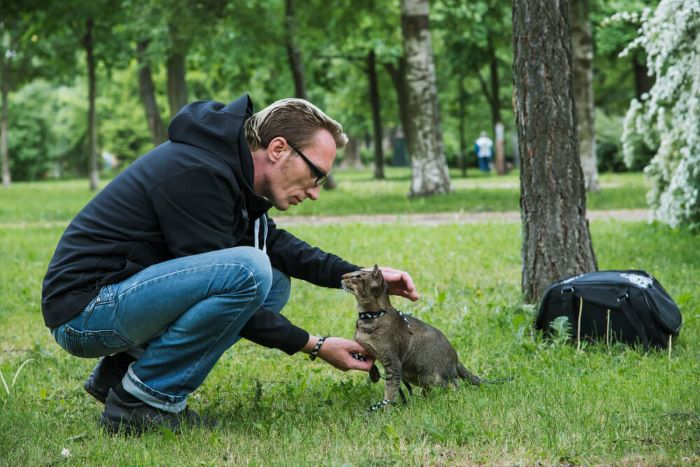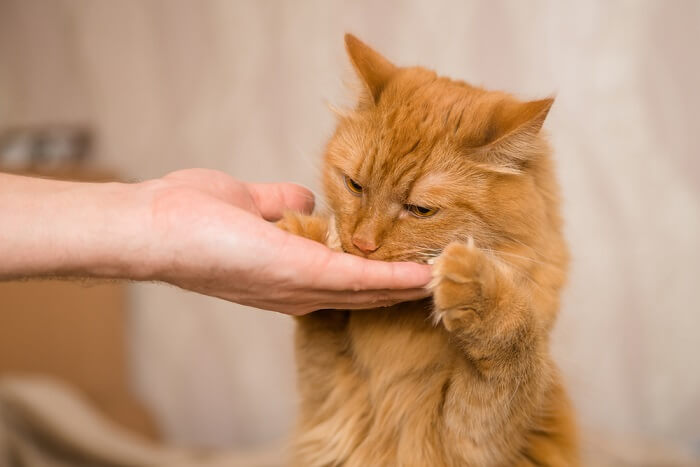
More and more cat lovers are seeing that not only is cat training easy, it’s also a fun activity for all family members. For indoor cats that don’t get enough enrichment, time spent training will become a highlight of their day and keep them from destructive behaviors due to boredom.
Training your cat will teach them fun tricks and practical skills while meeting their daily needs for positive human-cat social interaction.
1. Get a Clicker
Cat clicker training relies on positive reinforcement principles; we give the cat a treat for a job well done, and they learn to offer behaviors in exchange for rewards. A clicker is a useful tool to provide clear training instructions.f
The clicker is a small handheld device that makes a clicking sound when pressed. We teach the cat that one click equals one treat, and the clicking sound becomes a marker that tells your cat they did something right and a treat is coming.
Think of a clicker like taking a snapshot of the action you want to reward. For example, when teaching a cat to high five, you would click at the split second they raise their paw, so they know they got rewarded for that specific action.
Once the cat learns that lifting their paw is the desired behavior, they will repeat the paw lift to keep this game going. As long as you remember that behavior that gets rewarded gets repeated, you are well on your way to becoming a master at training your cat.
2. Find Food Rewards That Your Cat Loves

For clicker training to work, we need to find a reward that your cat values. For cat owners, this can be the most challenging step in the process because many cats eat from a bowl of cat food left out all day, which decreases the value of the food – there’s a reason people get paid AFTER they do the work, not before!
You can reinforce your cat’s good behavior with their meals provided that it’s not left out all day for them to free-feed. Introduce small, scheduled meals to build your cat’s food motivation.
Before your cat’s mealtime, use a portion of their food for training. If you feed your cat wet or raw food, the reward can be a few licks of their food off a spoon. If you give your cat kibble, you can use a handful of the pieces as rewards.
After training, put the rest of their meal down like a jackpot for all their hard work. The more rewards you have for your cat, the easier training will be. Many cats will also work for healthy cat treats, such as little pieces of freeze-dried chicken.
Working for food is an excellent way for your cat to expend energy and enrich their life.
3. Capture a Behavior – Teach Your Cat To Sit
Once you have a reward that your cat likes, pick a skill you want to work on and see how you can create a situation to encourage your cat to offer that behavior so you can “capture” it with the clicker. Teaching sit is an easy trick to train because most cats will sit throughout the day, giving you an excellent opportunity to practice using the clicker.
Grab your clicker and wait until your cat sits. Click as soon as their bum hits the ground and toss them a treat. Your cat will quickly catch on that the clicking sound predicts a treat. Because behavior that gets rewarded gets repeated, you should see your cat look at you and offer the sit to earn rewards.
4. Add a Signal
When your cat is doing a sit reliably, you can put the behavior “on cue.” A cue can be a hand signal or a verbal signal to indicate to your cat that you are willing to “pay” for the behavior. For sit, you might choose to add the verbal cue, “Sit.”
To teach the verbal cue, say the word just as you see your cat move into the position. Practice pairing the verbal signal with the behavior over several repetitions until you see your cat start to respond to the word when you say it.
The final step is to only reward your cat for sitting when you say, “Sit.”
5. Have Fun Training!

Once you’ve gathered your gear, the next step is training your cat to walk on a leash.
Using the capturing method, you can teach lots of cute tricks and behaviors. Does your cat like to roll over or go up on their back paws? Grab your clicker and see what you can capture. To keep your cat’s attention, training sessions should be fun, easy and short, like 3 to 5 minutes.
Stop That! How To Improve Your Cat’s Behavior
What about using training to STOP your cat from doing something, for example, jumping on the kitchen counter?
Most people focus on teaching their cat to respond to a verbal command like “No,” but this is not the best approach because it doesn’t teach your cat what you want them to do instead. Imagine arriving at a dinner party where there’s a big table with place settings for ten people, you pick a spot and sit down, and the host says, “don’t sit there.” You get up and move to another seat, and again the host asks you to move.
Now you are starting to wonder, where CAN you sit. Imagine how your cat feels when you say “NO!” Your cat has no clue what you want them to do.
From their perspective, they are either hungry or looking for your attention, and when you tell them NO, it doesn’t solve the underlying reason why they are doing the behavior in the first place. It’s a lot easier for humans and cats when instructions are clear: “Have a seat in this spot, and I will bring you a snack.”
Teach your cat where you want them to go, and then reward them a lot! Remember to make the new spot just as appealing as their previously loved spot.
Back to our dinner party example – if the host puts you off to the side at the kid’s table when you want to hang out with the adults, you won’t be happy. Likewise, if you try to create a new “parking spot” for your cat on the floor and they want to have a clear view of everything you are doing in the kitchen, this isn’t going to work because it doesn’t fulfill your cat’s needs.
Help Your Cat Overcome Fears
What if you have trouble brushing your cat or clipping their nails?
We have to switch gears and use a different training method, called desensitization and counter-conditioning. The desensitization part is where we present the object or experience your cat doesn’t like at a level that they can tolerate.
Let’s say you are scared of going in an elevator because you feel claustrophobic in a small space. In that case, I need to help you feel comfortable in a small enclosed area first before we can get you comfortable in a moving elevator.
We might spend the first session where all you do is go in and out of a stationary elevator. At this stage, you might only be able to enter the elevator for one second before it’s too scary.
Over several sessions of stepping in and out of a stationary elevator, we can work up to ten seconds and then eventually a minute. The point of desensitization is to introduce the scary thing in a way that it’s doable.
The counter-conditioning part of the process helps you respond positively to being in the elevator. I could do that by making something good happen when you go into the elevator. Let’s say you love chocolate, and I give you a piece of chocolate every time you step into the elevator.
Two things are happening in this training: you are learning that the elevator isn’t scary and that when you go in the elevator, you get chocolate, something you love. As long as we don’t rush the training, you can learn that the elevator is safe and enjoyable (because of chocolate!).
If your cat HATES when you touch their paws, you will need to touch them at a spot they can tolerate (maybe the top of their leg or their chest) and then present them with a delicious treat. Glide your hand from the body part where your cat is comfortable with the touch to the area that they can tolerate (they notice you touching the new zone and are concerned but not fearful, i.e., walking away) and present the food they love.
Consider the elevator example and how easy I made the desensitization process. If I had you go in a moving elevator right from the start, I would have expected too much. To improve your cat’s response to nail trims and handling, it helps to have a comprehensive training plan written out by a feline behaviorist.
Help Your Cat Put Their Best Paw Forward

Combine both of these training methods (clicker training and desensitization/counter-conditioning) to achieve all your training goals.
Clicker training teaches your cat they are in control of their environment. It is your cat’s choice to participate in the activity and offer the actions. For example, if you are teaching your cat to stay in a carrier, with clicker training, your cat is in control of how long they stay in there – it’s their choice to go in and stay in to earn rewards.
This type of training creates a happy and confident cat. Desensitization and counter-conditioning help your cat at an emotional level to overcome fears. If you want to accelerate progress, it pays to combine both of these methods.
For example, for nail trim training, you can show your cat that touching their paws isn’t scary AND teach them that giving you low-fives and paw shakes equals treats and attention.
Whether you want to teach your feline friend skills and tricks, help them go in the litter box, redirect their couch scratching to a scratching post, improving your cat’s behavior is 100% possible, and both older cats and kittens can learn. Focus on fun training and positive methods to set your cat up for a successful learning experience.
Also Read: The 10 Best Cat Slow Feeders & Puzzle Feeders
Frequently Asked Questions:
Are cats easy to train?
Yes, as long as you use positive reinforcement training, cats are trainable. To train a cat, you need to have a reward that they value – using food as a paycheck is the easiest way to teach your cat lots of tricks and skills.
How do you train your cat?
Clicker training is an excellent cat training method for teaching your cat an extensive repertoire of behaviors.
Can you teach a cat commands?
Cats can learn lots of tricks and useful behaviors. Think of cat training like teaching your cat signals that both of you understand. Commands imply that your cat doesn't have a choice, while cues (signals) mean it's your cat's option to participate.
How do you train a new cat?
Food puzzles are an excellent way to introduce a new cat to work for their food and prepare them for training. Hide your cat's food or treats in a puzzle toy and see if they will solve the puzzle, i.e., get the food out. If your new cat is comfortable eating around you and interacting with the puzzle, you will be ready to introduce them to clicker training. Pick an easy behavior to start, like teaching them to sit.








How do you train a cat to allow brushing their teeth?
Hi Niki, that’s a great question. You may need to get your cat used to it over the course of a week or two. You can start by putting a little cat toothpaste on your finger and letting your cat lick it off, so he gets used to the taste. Never use human toothpaste for cats. Once your cat gets used to the toothpaste, try offering it on a toothbrush. When your cat starts to lick it off, see if you can insert the toothbrush into his mouth a little bit and move it in brushing motions along his teeth and gum line. Eventually, your cat will get used to having the toothbrush in his mouth and you can actually start brushing his teeth. You may only be able to do one side of his mouth or a few teeth at a time but do what you can and try to brush all of his teeth several times a week.
Thanks for all the info!
I need to improve my 3 cats’ response to nail trims and general foot handling. I’ve read that it helps to have a comprehensive training plan written out by a feline behaviorist. How can I find a feline behaviorist, get a training plan, and how much might this cost. I’m 73, my youngest cat is 16, (I think), and several of their nails are growing into their pads. I don’t have a lot of money. Thank you.
Hi Sue, I will forward your message to one of our team’s feline behaviorists, Melina Grin, and see if she would be interested in helping you out. Until then, you might like our article on how to trim your cat’s nails: https://cats.com/how-to-trim-cat-nails
Hi Sue,
Thank you for your patience, Melina here from All About Cats Behaviour Team.
You are correct, improving your cats’ response to general foot handling is the starting point. Here’s a wonderful video by International Cat Care of paw handling and clipping acceptance: https://www.youtube.com/watch?v=V8SMinphtB4&t=91s
Trimming nails can be a stressful event for both cats and owners, but it doesn’t have to be. Here are some important things you need to keep in mind prior to starting a training session:
Have all the required equipment and treats ready prior to start of training. We use and recommend JW Grip Soft nail clippers: https://www.petnurture.com.au/product/jw-gripsoft-dog-cat-nail-clipper-small/
Toes have a high density of nerve endings, some cats may resist having it’s paw pulled out.
Some cats are more sensitive on their front feet than the back feet – always gauge their body language.
You may never be able to trim all nails in one session, that’s perfectly alright.
Some cats may never accept cooperative nail clipping due to previous negative experiences, and that is okay.
You might make a routine of trimming one nail every day or two consistently.
There are several training methods such as shaping (involves clicking and rewarding small steps) desensitization and counter-conditioning.
I usually start with teaching a cue such as “Shake Hands”, however if your cat doesn’t know how to shake hands you can try the following with treats or food they like:
1. Place the nail clippers nearby where the cat can see them, if you’re using a clicker, click and treat.
2. Get your cat used to the sound of the clippers before attempting to trim her nails, click and treat.
3. While the cat is in your lap or relaxed on a bed, shape the following steps:
A. Reach toward one paw, if it’s too sensitive, start by touching the shoulder and move down the leg to the paw.
B. Gently touch one paw for a second, increase gradually the time to three seconds.
C. Lift the paw a bit for a second, gradually increase to three seconds by holding it gently.
D. Once more lift the paw and press on one toe only. Slowly increase the pressure on the toe until you can extend one claw.
E. While the claw extended reach towards one toe with the nail clippers, but don’t touch it, just hover above.
F. Touch the extended claw with clippers.
G. Clip one nail (the white or grey part only, the pink park is called the Quick, DO NOT cut this sensitive area). Better to cut less than more.
H. I would end the session now on a high note with play or food.
I. Tomorrow or next day continue clipping two more or all the nails on one paw only.
Another great close-up video by ICatCare on how to successfully clip your cat’s claws: https://www.youtube.com/watch?v=U36rsW_WhUA
For cats that are food driven, you can try nail clipping without even picking up a paw as depicted in these videos: https://www.youtube.com/watch?v=8vm5iaZVvRk and https://www.youtube.com/watch?v=3a4NXKf-TOw
If you’re still struggling and don’t have family or friends who are able to help you, I’m happy to write up a detailed training plan next month, please let us know if you made any progress and how’s its going overall, best regards Melina
You can try trimming it’s nails when the cat is sleeping if the cat has a strong connection with you. The cat chose us not the other way around. We opened the door to the house and she burst in.